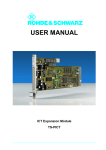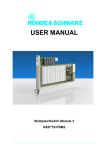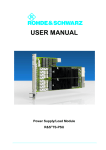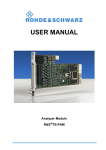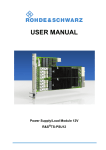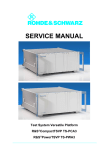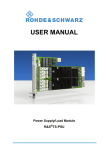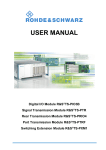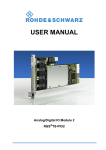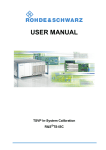Download USER MANUAL - Rohde & Schwarz
Transcript
USER MANUAL Power Switch Module TS-PSM1 User Manual for ROHDE & SCHWARZ Power Switch Module TS-PSM1 3rd Issue / 11.05 / GB 1143.0468.12 All rights, also translation into foreign languages, are reserved. No part of this manual is permitted to be reproduced in any form (print, photocopy or any other method), also not for the preparation of lectures, or processed, reproduced or made available using electronic systems without written permission from ROHDE & SCHWARZ. © The passing on to third parties and the reproduction of this documentation, utilisation and communication of its contents is not permitted unless specifically approved. Infringements will incur claims for damages. All rights reserved in the case of the award of a patent or registration of a design. We draw to your attention that the names of software and hardware used in the Service Manual, and the brand names of the respective companies are, in general, the subject of protection as trademarks, or under proprietary rights, or patent law. ROHDE & SCHWARZ GmbH & Co. KG Corporate Headquarters Mühldorfstr. 15 D-81671 München Telephone: Fax: ...49 (0)89/4129-13774 ...49 (0)89/4129-13777 Printed in the Federal Republic of Germany. Errors excepted, subject to technical change without notice. Safety Instructions Attention! Electrostatic sensitive devices require special care Support Center Telephone Europe: +49 180 512 42 42 Telephone worldwide: +49 89 4129 13774 Fax: +49 89 4129 13777 e-mail: [email protected] If you have any technical queries about this Rohde & Schwarz equipment, our Hotline at the Support Center of Rohde & Schwarz Sales-GmbH will be glad to help. Our team will discuss your queries and look for solutions to your problems. The Hotline is open Mondays to Fridays from 08.00 to 17.00 hrs. For queries outside office hours, you can leave a message or send a note via fax or email. We will then get back to you as soon as possible. Power Switch Modul TS-PSM1 Contents Contents 1 Usage 1-1 1.1 General 1-1 1.2 Characteristics 1-2 2 View 2-1 3 Block Diagram 3-1 4 Layout 4-1 4.1 Mechanical Layout 4-1 4.2 Display Elements 4-2 Function Description 5-1 5.1 Signal Concept 5-1 5.2 System Functions 5-1 5.3 Flexibility 5-2 5.4 Compact Design 5-2 5.5 Noise Immunity 5-2 5 6 7 3rd Issue 11.05 8 9 Commissioning 6-1 6.1 Installing the Plug-In Module 6-1 6.2 Initializing the Plug-In Module 6-1 Software 7-1 7.1 Driver Software 7-1 7.2 Softpanel 7-2 7.3 TS-PSM1 Program Example 7-3 Self-Test 8-1 8.1 LED Test 8-1 8.2 Power-On Test 8-1 8.3 TSVP Self-Test 8-1 Interface description 9-1 9.1 9-1 Connector X1 3 Contents Power Switch Modul TS-PSM1 9.2 Terminal X2 9-2 9.3 Terminal X3 9-2 9.4 Connector X10 9-3 9.5 Connector X20 9-5 9.6 Connector X30 9-6 10-1 3rd Issue 11.05 10 Specifications 4 Power Switch Modul TS-PSM1 Figures Figures View of the TS-PSM1 .........................................................................2-1 Figure 3-1 Block Diagram TS-PSM1 ...................................................................3-1 Figure 3-2 Functional Block Diagram TS-PSM1................................................3-2 Figure 4-1 Layout of Connectors and LED's .....................................................4-1 Figure 7-1 Softpanel TS-PSM1 (example) ..........................................................7-2 Figure 9-1 Connector X1 (mating side) ..............................................................9-1 Figure 9-2 Terminal X2 ........................................................................................9-2 Figure 9-3 Terminal X3 ........................................................................................9-2 Figure 9-4 Connector X10 (mating side) ............................................................9-3 Figure 9-5 Connector X20 (mating side) ............................................................9-5 Figure 9-6 Connector X30 (mating side) ............................................................9-6 3rd Issue 11.05 Figure 2-1 5 Power Switch Modul TS-PSM1 3rd Issue 11.05 Figures 6 Power Switch Modul TS-PSM1 Tables Tables Characteristics TS-PSM1 ..................................................................1-2 Table 4-1 Connectors on the TS-PSM1 ............................................................4-2 Table 4-2 Display elements on the TS-PSM1 ...................................................4-2 Table 7-1 Driver Installation TS-PSM1..............................................................7-1 Table 8-1 Statements about the LED Test........................................................8-1 Table 9-1 X1 Pinning Assignment.....................................................................9-1 Table 9-2 X10 Pinning Assignment...................................................................9-3 Table 9-3 X20 Pinning Assignment...................................................................9-5 Table 9-4 X30 Pinning Assignment...................................................................9-6 3rd Issue 11.05 Table 1-1 7 Power Switch Modul TS-PSM1 3rd Issue 11.05 Tables 8 Power Switch Module TS-PSM1 Usage 1 Usage 1.1 General The ROHDE & SCHWARZ Power Switch Module TS-PSM1 is designed for interconnecting or distributing high voltages or current. Currents/voltages at all switching nodes can be measured or monitored with the analog bus. These functions are particularly important when the test component's current demand in both normal and standby mode has to be measured. The TS-PSM1 can be used in the CompactTSVP and the PowerTSVP (TSVP = Test System Versatile Platform). It is fitted into the front of the TSVP chassis. The front connector ends flush with the front panel of the TSVP chassis and is used for contacting the test products. An adapter frame can also be used if necessary. 3rd Issue 11.05 At the back the TS-PSM1 is connected to the CAN/PXI bus and the analog bus of the TSVP chassis. The high power lines are taken to the rear of the TS-PSM1 via connection terminals and a 12-pin plug connector. 1-1 Usage Power Switch Module TS-PSM1 1.2 Characteristics Characteristics TS-PSM1 Power switching module for supplies and loads Switching module for high voltages (max. 60 V) 8 high power channels (max. 16 A) 10 low power channels (max. 2 A) 4 high power MUX channels 4 : 1 (max. 16 A) Indirect current measurement on high power channels with shunt Direct current measurement on all channels by R&S analog bus and TS-PSAM plug-in module (<1 A) Self-test of all relays by analog bus and TS-PSAM plug-in module Control bus: CAN For use in CompactTSVP and PowerTSVP 3rd Issue 11.05 Table 1-1 Characteristics TS-PSM1 1-2 Power Switch Module TS-PSM1 View 2 View Figure 2-1 shows a view of the TS-PSM1 . 3rd Issue 11.05 Figure 2-1 View of the TS-PSM1 2-1 Power Switch Module TS-PSM1 3rd Issue 11.05 View 2-2 Power Switch Module TS-PSM1 Block Diagram 3 Block Diagram 3rd Issue 11.05 Figure 3-1 shows the block diagram of the TS-PSM1. A simplified view of the functional block can be seen in Figure 3-2 . Figure 3-1 Block Diagram TS-PSM1 3-1 Block Diagram Power Switch Module TS-PSM1 3rd Issue 11.05 Figure 3-2 Functional Block Diagram TS-PSM1 3-2 Power Switch Module TS-PSM1 Layout 4 Layout 4.1 Mechanical Layout The TS-PSM1 is designed as a long plug-in board for front mounting in the TSVP chassis. The mounting depth is 300 mm, and the front panel is 4U in height. Connector X20 is used to make the connections with the cPCI backplane / control backplane of the TSVP. Connector X30 connects the TS-PSM1 with the analog bus backplane in the TSVP chassis. The high power connections are routed across the rear connector X1 and terminals X2, X3. Test products and peripherals are connected using front connector X10 . 3rd Issue 11.05 Figure 4-1 Layout of Connectors and LED's 4-1 Layout Power Switch Module TS-PSM1 Symbol Use X1 High Power Connector X2 High Power Terminal X3 High Power Terminal X10 Front Connector X20 PXI/Extension Connector X30 Analog Bus Connector Table 4-1 Connectors on the TS-PSM1 4.2 Display Elements (see Figure 4-1 ) The front panel of the TS-PSM1 contains three light-emitting diodes (LED's) with the following functions: LED Description ERR (red) Fault condition: Lights up when a fault is detected on the TS-PSM1 in the power-on test after the supply voltage is switched on. COM (yellow) Communication: Lights up briefly when the TS-PSM1 is accessed via the interface. PWR (green) Power: Lights up when all supply voltages are present. Table 4-2 Display elements on the TS-PSM1 When voltage is powered up all three LED's light up for around 1 second. This ensures that the 5 V supply is present and that the LED's and power-on test are functioning. 4-2 3rd Issue 11.05 LED Test: Power Switch Module TS-PSM1 Function Description 5 Function Description (see Section 3, Block Diagram and Functional Block Diagram) 5.1 Signal Concept The special design of the TS-PSM1 guarantees the ideal guiding of supply and load paths through the test system. Both “Force” channels with high currents and “Sense“ channels of voltage/current sources are guided across the TS-PSM1 to the components on test. In the opposite direction, test components can be injected with loads with one or a number of poles. With the High Power Multiplexers it is possible to select different load simulations that can be integrated in the TSVP chassis. The currents and voltages can be measured and monitored at all switching nodes with additional relays on the TS-PSM1 and the analog bus (high currents with shunts). 5.2 System Functions The system functions are implemented by a local processor with internal flash. An external SRAM is also provided. Communication with the system controller in the CompactTSVP is conducted on the CAN bus. The functions of the TS-PSM1 can be summarized as follows: Analog function test • Connection of voltage/current sources • Connection of test component loads (original loads, simulated/ electronic loads) • Power Multiplexer • Switch simulation 3rd Issue 11.05 • 5-1 Function Description Power Switch Module TS-PSM1 5.3 Flexibility The construction of the TS-PSM1 and its wide range of voltages and currents ensure a high level of flexibility and a broad range of applications. As well as being used in the ROHDE & SCHWARZ CompactTSVP and PowerTSVP, the TS-PSM1 can also be operated remotely in the UUT adapter or in a load box. Even complex, yet flexible load systems can be implemented with original loads and/or electronic loads by the multiple module-internal connection of power channels to form a high current bus in the PowerTSVP. The high-power sources or loads are fed thru connector X1 to the UUT. The preferred slot in the CompavctTSVP is slot 16. If single high power switches are needed, the terminals X2 and X3 can be used to reconnect the second pole to the front connector. Application specific cable and additional front panel are necessary. In the CompactTSVP, only slot 16 allows usage of connector X1 to pass thru the signals from/to the back. 5.4 Compact Design The space-saving design of the TS-PSM1 (1 slot) with voltage/current monitoring and self-test on the analog bus allows the creation of very powerful and compact measurement and load systems with up to 12 modules in the CompactTSVP and 16 modules in the PowerTSVP. These can be incorporated directly and hence very cost-effectively in production cells. Optimum response to electrical interference or rises in temperature is achieved by the controller on the serial differential CAN bus (Controller Area Network). 5-2 3rd Issue 11.05 5.5 Noise Immunity Power Switch Module TS-PSM1 Commissioning 6 Commissioning 6.1 Installing the Plug-In Module The install the TS-PSM1 plug-in module, proceed as follows: • Run down and power off the TSVP • Select a suitable front slot (preferred slot 16 in CompactTSVP). • Remove the front panel from the TSVP chassis by slackening off the screws. WARNING! Check the backplane connectors for bent pins! Any bent pins must be straightened! Failure to do this may permanently damage the backplane! • Push in the plug-in module using moderate pressure • The top snap pin on the module must locate in the right-hand and the bottom pin in the left-hand hole on the TSVP chassis WARNING! Use both hands to guide the module and carefully plug it into the backplane connectors • The module is correctly located when a distinct 'stop' can be felt • Tighten the top and bottom screws on the front panel of the plugin module 6.2 Initializing the Plug-In Module 3rd Issue 11.05 Once the system has been powered up, the TS-PSM1 is initialized. Signals GA0 ... GA5 on the cPCI bus are used for slot detection. 6-1 Power Switch Module TS-PSM1 3rd Issue 11.05 Commissioning 6-2 Power Switch Module TS-PSM1 Software 7 Software 7.1 Driver Software A LabWindows CVI driver is provided for the TS-PSM1 . This driver satisfies the IVI Switch specification. The driver is part of the ROHDE & SCHWARZ GTSL software. All the functions of the driver are described fully in the on-line help and in the LabWindows CVI Function Panel. The following software modules are installed during driver installation: Module Path Remarks rspsm1.dll <GTSL Directory>\Bin Driver rspsm1.hlp <GTSL Directory>\Bin Help file rspsm1.fp <GTSL Directory>\Bin LabWindows CVI Function Panel file, Function Panels for CVI development environment rspsm1.sub <GTSL Directory>\Bin LabWindows CVI attribute file. This files is needed by some „Function Panels“. rspsm1.sub <GTSL Directory>\Bin Import library rspsm1.h <GTSL Directory>\Include Header file for the driver Table 7-1 Driver Installation TS-PSM1 NOTE: 3rd Issue 11.05 The IVI and VISA libraries of National Instruments are needed to run the driver. 7-1 Software Power Switch Module TS-PSM1 7.2 Softpanel Figure 7-1 Softpanel TS-PSM1 (example) 7-2 3rd Issue 11.05 The software package of the TS-PSM1 includes a so-called softpanel (see example in Figure 7-1). The softpanel enables the user to execute the functions of the TS-PSM1 listed in the menu with on-screen mouse clicks. Power Switch Module TS-PSM1 Software 7.3 TS-PSM1 Program Example /* Simple connection between ABa1 and ABb1 with TS-PSM1 in Slot 16 The coding rules of a GTSL software like allocating and locking the resource, or error handling are not considered in this example. It´s just to show the function calls to get the connection. */ #include "rspsm1.h" static ViStatus /* rspsm1 ivi-driver header file */ s_status; main() { /* Creates a new IVI instrument driver and optionally sets the initial state of the session attributes. "CAN0::0::1::16": CAN board 0, Bus Controller 0, Frame 1, Slot 16 */ s_status = rspsm1_InitWithOptions ("CAN0::0::1::16", VI_TRUE, VI_TRUE, "", & handle); /* This function creates a path between channel ABa1 and LABa1. The driver calculates the shortest path between the two channels. */ s_status = rspsm1_Connect (handle, "ABa1", "LABa1"); s_status = rspsm1_Connect (handle, "ABb1", "LABb1"); s_status = rspsm1_Connect (handle, "CH1com", "LABa1"); s_status = rspsm1_Connect (handle, "CH1no", "LABb1"); s_status = rspsm1_Connect (handle, "CH1com", "CH1no"); 3rd Issue 11.05 /* Connection between ABa1 and ABb1 exists. */ /* Opens the path between Channel ABa1 and LABa1. */ s_status = rspsm1_Disconnect (handle, "CH1com", "CH1no"); 7-3 Software Power Switch Module TS-PSM1 s_status = rspsm1_Disconnect (handle, "CH1com", "LABa1"); s_status = rspsm1_Disconnect (handle, "CH1no", "LABb1"); s_status = rspsm1_Disconnect (handle, "ABa1", "LABa1"); s_status = rspsm1_Disconnect (handle, "ABb1", "LABb1"); s_status = rspsm1_close (handle); 3rd Issue 11.05 } 7-4 Power Switch Module TS-PSM1 Self-Test 8 Self-Test The TS-PSM1 has a built-in self-test capability. The following tests are possible: • LED Test: • Power-on test • TSVP Self-Test 8.1 LED Test After power-on, all three LED's light up for around one second to indicate that the 5 V supply is present, all LED's are working and the poweron test was successful. The following statements can be made about the different LED statuses: LED Description One LED does not light up Hardware problem on the module No LED's light up No +5V supply Table 8-1 Statements about the LED Test 8.2 Power-On Test The power-on test runs at the same time as the LED test. The red LED lights up if a fault is found on the module. This is just a test of the firmware of the TS-PSM1 . 3rd Issue 11.05 8.3 TSVP Self-Test The TSVP self-test runs an in-depth test on the module and generates a detailed log. 8-1 Self-Test Power Switch Module TS-PSM1 The TS-PSAM modules is used as a measuring unit of R&S modules in the TSVP. The correct operation of the modules is ensured by measurements on the analog bus. NOTE: 3rd Issue 11.05 You will find information about starting the self-test and on the sequence of necessary steps in the Service Manual. 8-2 Power Switch Module TS-PSM1 Interface description 9 Interface description 9.1 Connector X1 1 7 6 12 Figure 9-1 Connector X1 (mating side) Pin Signal Pin Signal 1 LPBA 7 CH1 COM 2 CH2 COM 8 CH6 COM 3 CH3 COM 9 CH4 COM 4 LPBB 10 LPBD 5 CH5 COM 11 CH7 COM 6 CH8 COM 12 LPBC 3rd Issue 11.05 Table 9-1 X1 Pinning Assignment 9-1 Interface description Power Switch Module TS-PSM1 9.2 Terminal X2 Figure 9-2 Terminal X2 9.3 Terminal X3 3rd Issue 11.05 Figure 9-3 Terminal X3 9-2 Power Switch Module TS-PSM1 Interface description 9.4 Connector X10 1 32 A BC Figure 9-4 Connector X10 (mating side) 3rd Issue 11.05 Pin A B C 1 CH1_NO CH1_NO CH1_NO 2 CH1_NO CH1_NO CH1_NO 3 CH1_NO CH1_NO CH1_NO 4 CH2_NO CH2_NO CH2_NO 5 CH2_NO CH2_NO CH2_NO 6 CH2_NO CH2_NO CH2_NO 7 CH9_NO CH10_NO CH11_NO 8 CH9_COM CH10_COM CH11_COM 9 CH3_NO CH3_NO CH3_NO 10 CH3_NO CH3_NO CH3_NO 11 CH3_NO CH3_NO CH3_NO 12 CH4_NO CH4_NO CH4_NO Table 9-2 X10 Pinning Assignment 9-3 Interface description Power Switch Module TS-PSM1 Pin A B C 13 CH4_NO CH4_NO CH4_NO 14 CH4_NO CH4_NO CH4_NO 15 CH12_NO CH13_NO CH14_NO 16 CH12_COM CH13_COM CH14_COM 17 CH5_NO CH5_NO CH5_NO 18 CH5_NO CH5_NO CH5_NO 19 CH5_NO CH5_NO CH5_NO 20 CH6_NO CH6_NO CH6_NO 21 CH6_NO CH6_NO CH6_NO 22 CH5_NO CH6_NO CH6_NO 23 CH15_NO CH16_NO GND 24 CH15_COM CH16_COM GND 25 CH7_NO CH7_NO CH7_NO 26 CH7_NO CH7_NO CH7_NO 27 CH7_NO CH7_NO CH7_NO 28 CH8_NO CH8_NO CH8_NO 29 CH8_NO CH8_NO CH8_NO 30 CH8_NO CH8_NO CH8_NO 31 IL1_NO IL2_NO GND 32 IL1_COM IL2_COM CHA-GND Table 9-2 X10 Pinning Assignment Note: 3rd Issue 11.05 Signals in bold print are High Power 9-4 Power Switch Module TS-PSM1 Interface description 9.5 Connector X20 22 F E D C BAZ Figure 9-5 Connector X20 (mating side) NC = not connected, NP = not populated 3rd Issue 11.05 Pin 22 21 20 19 18 17 16 15 14 13 12 11 10 9 8 7 6 5 4 3 2 1 F GND GND GND GND GND GND GND GND E D C B A GA0 GA1 GA2 GA3 GA4 PXI_LBR3 PXI_LBR2 PXI_LBR1 GA5 PXI_LBR0 PXI_LBL1 GND PXI_LBL0 AUX1 AUX2 AUX1 AUX2 PXI_LBL3 GND PXI_LBL2 PXI_TRIG3 PXI_TRIG6 GND PXI_TRIG5 PXI_TRIG4 PXI_CLK10 AUX4 AUX3 GND PXI_TRIG2 PXI_TRIG7 GND AUX5 PXI_TRIG0 PXI_TRIG1 +5V +5V AUX6 GND NC NC NP CH9_COM CH13_COM NP IL1_COM NC CH10_COM CH14_COM NC NC CH11_COM CH15_COM NC IL2_COM NC CH12_COM CH16_COM NC Z GND GND GND GND GND X20 GND GND GND NC C NC O NP N NP N NC E NC C NC T NC O NC R NC NC NC GND GND GND RSA0 RRST# +12V GND RSDO +12V RSDI RSA1 +5V RSCLK +5V CAN_L CAN_H GND RCS# Rear I/O GA3..0 at GND or N.C. GND GND GND Rear I/O incompatible PXI PXI Signals R&S Rear IO control (SPI) GA5..4 at jumper field. GA5 only TS-PWA3 Table 9-3 X20 Pinning Assignment 9-5 Interface description Power Switch Module TS-PSM1 9.6 Connector X30 Figure 9-6 Connector X30 (mating side) Pin 7 E A IL1_x ABc1 ABa1 ABb1 ABc2 2 1 B GND 4 3 C IL2_x 6 5 D ABb2 ABa2 ABd2 ABd1 Table 9-4 X30 Pinning Assignment Note: 3rd Issue 11.05 IL1_x = IL1 of the slot 9-6 Power Switch Module TS-PSM1 Specifications 10 Specifications NOTE: In the event of any discrepancies between data in this manual and the technical data in the data sheet, the data sheet takes precedence. Interfaces Control Bus CAN 2.0b (1 Mbit/s) UUT Connector (Front) DIN41612, 96 pins Rear I/O connector cPCI, 110 pins High Power Switching Channels Number/Relay Type 8 / Zettler AZ764 Contacts 8 x SPST Max. switching voltage 60 VDC / 42 VAC Max. switching current 12 A rms (continuously), 16 A pulsed max. 60 s (duty cycle: 1 period on / 3 periods off) Max. switching capacity 480 W On-time (typ.) 10 ms Off-time (typ.) 3 ms Switching cycles (mech.) 3 x 107 Current measurement (indirect) 8 x shunt, 10 mOhm Current measurement (direct) max. 1A / 10W with analog bus and TS-PSAM 3rd Issue 11.05 High Power Multiplexer Number/Relay Type 16 / Zettler AZ764 Contacts 4 x 4-to-1 Max. switching voltage 60 VDC / 42 VAC Max. switching current 12 A rms (continuously), 16 A pulsed max. 60 s (duty cycle: 1 period on / 3 periods off) 10-1 Specifications Max. switching capacity Power Switch Module TS-PSM1 480 W Low Power Interface Number/Relay Type 10 / Zettler AZ832 Contacts 10 x SPST Max. switching voltage 60 VDC / 42 VAC Max. switching current 2A Max. switching capacity 150 W On-time (typ.) 3 ms Off-time (typ.) 2 ms Switching cycles (mech.) 2 x 107 Current measurement (direct) max. 1A / 10W with analog bus and TS-PSAM Monitor Switching Channels Number/Relay Type 6 / Meder RM-05 Contacts 12 x 4-to-1 Max. switching voltage 60 VDC / 42 VAC Max. switching current 1 A (1.5 A load rating) Max. switching capacity 10 W On-time (typ.) 0.5 ms Off-time (typ.) 0.2 ms Switching cycles (mech.) 1 x 109 10-2 EMC according to EMC Directive 89/336/EEC and Standard EN61326 Safety CE, EN61010 Part 1 Shock 40 g, MIL-STD-810, MIL-T-28800, class 3 and class 5 Sinusoidal Vibration 5 Hz to 55 Hz 55 Hz to 150 Hz 2 g, MIL-T-28800D, class 5 0.5 g, MIL-T-28800D, class 5 3rd Issue 11.05 Environmental conditions Power Switch Module TS-PSM1 Specifications Noise 10 Hz to 300 Hz 1.2 g Humidity +25 °C / +40 °C, 95% humidity General Data Dimensions 316 x 174 x 20 mm Weight 780 g Nominal temperature range +5 °C to +40 °C Operating temperature range 0 to +50°C Storage temperature range -40 °C to +70 °C Power consumption 22.5 W max. Order number Power Switching Module TS-PSM1 1143.0139.02 Software 3rd Issue 11.05 GTSL basic software, CVI driver 10-3














































